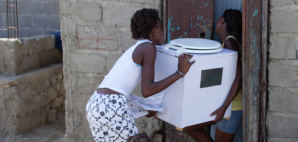World Toilet Day: Not All Can Flush and Forget
« Back to Publications Author: jennifer davis
 Residents of a slum in Cap Haitien, Haiti bring home a container-based toilet
Residents of a slum in Cap Haitien, Haiti bring home a container-based toilet Photo credit: Felipe Jacome
World Toilet Day: Not All Can Flush and Forget
Chances are most people in the developed world can easily access a safe, convenient toilet. Globally, however, more than one in four people live in a world without access to a decent sanitation facility.
On World Toilet Day - November 19 - and every day, the global health community focuses on the needs of more than 1 billion people who defecate in the open. Poor sanitation contributes to thousands of deaths from diarrheal diseases every year. A lack of secure and private restrooms for women and girls also increases the risk of rape and abuse, and causes many girls to stop attending school. Equitable sanitation access can no longer afford to be a neglected global issue. Gains in sanitation coverage in sub-Saharan Africa and South Asia have not even been able to keep pace with population growth, particularly in urban areas.
To tackle this challenge, the United States and other members of the United Nations General Assembly recently approved ambitious goals for water supply and sanitation services over the next 15 years. Jenna Davis, associate professor of civil and environmental engineering at Stanford and Higgins-Magid Senior Fellow at the Stanford Woods Institute for the Environment, worked with a United Nations team to develop the targets and indicators that will be used to monitor access to sustainable sanitation.
“I feel particularly proud of the group’s success in broadening the definition of sustainable sanitation,” Davis said. “The definition extends beyond toilet use to include the safe management and disposal of wastes.”
What kind of toilets are people around the world using? Five examples:
1. Flying Toilets (far from ideal)
Roughly one in seven people worldwide defecate in the open or use plastic bags — termed “flying toilets” — that they throw as far as possible when they’re done. Flying toilets are commonly used everywhere from Haiti to Kiberia, Africa’s largest urban slum. These practices directly expose children and adults to harmful bacteria, and can contaminate drinking water, especially during floods. Additionally, flies can easily access feces and spread germs to food sources. Open defecation is the least safe waste disposal option.
2. Bag and Bury It (good for emergencies)
A U.N. study indicated that worldwide, almost one third of refugee camps do not have adequate latrines or waste disposal services. For example, in early November, several NGOs denounced “serious human rights violations” due to lack of sanitation services at a migrant camp in Calais, France that held thousands of refugees. This prompted a court in to order the town to install 50 latrines to improve sanitation, according to The Guardian. Another sanitation option is a single-use biodegradable toilet, which can serve as a transition solution for such emergency situations. Not only does the biodegradable bag prevent contamination — if processed properly, it can later be converted to compost.
3. Covered Latrines (community buy-in makes the difference)
Covered latrines — pits that store fecal matter and are sealed when full — are one low-tech solution to open defecation. A program underway in over 50 countries, “community-led total sanitation” uses behavior change techniques to motivate communities to stop open defecation by building — and using — pit latrines. Among the promising results of the effort, increased latrine use has reduced stunting among young children in the communities, according to a study co-authored by a Stanford researcher.
4. Container-Based With Subscription Waste-Removal (no plumbing required)
A waterless toilet and waste collection service being piloted in Haiti and other countries may provide a significant health benefit in dense urban settings. A key feature of the waterless toilet — built to resemble a modern flush toilet — is that it separates solid and liquid waste into sealable containers. The liquid can be disposed of in the natural environment, while solids are mixed with a cover material made of natural material such as crushed peanut shells and sugarcane fibers, which absorb odors and reduce insect infestations. The solid waste is regularly removed and taken to a disposal or processing site where it can be converted to compost.
Uptake of this new technology requires behavior change and a willingness to pay for the service. Both requirements were largely met in a study led by researchers with the Stanford Woods Institute’s Water, Health & Development program.
5. Full-Featured Flush (taps water and energy)
When most residents of the developed world think of a toilet, they imagine a ceramic bowl plumbed to a water source. This system, while convenient and sanitary, allows people to “flush and forget” — once they flush the toilet, they don’t need to think twice about the complex process that ensues, using large quantities of water to send waste to a community sewage plant where solids and liquids are treated to safety standards and released to surface waters.
While obtaining potable water is a major challenge for people in developing countries, many wealthy countries are going through great efforts to treat water to drinking standards — and then using it for their toilets. But some cities are leading the way. For example, Hong Kong has a long history of dual systems in which potable water is used for sinks and showers, and non-potable water is used for flushing toilets. San Francisco is working to make it easier for residents to install systems that use “grey-water” from sinks and showers to flush toilets or water gardens.
If you are lucky enough to have a flush toilet, rather than “flush and forget”, consider investigating where your water comes from and where your sewage ends up. This may make you “flush and feel thankful” that your sewage isn’t contaminating your local drinking water and surrounding environment.
